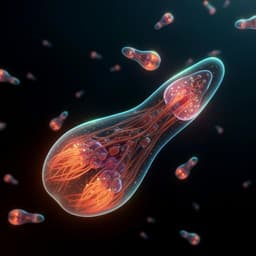
Engineering and Technology
Multi-sensing yarns for continuous wireless sweat lactate monitoring
B. Napier, G. Matzeu, et al.
Discover an innovative advancement in wearable technology with textile-integrated sensors by Bradley Napier, Giusy Matzeu, and Fiorenzo G. Omenetto. This research presents a breakthrough in electrochemical yarns to enable seamless, real-time sweat analysis directly from clothing, providing a powerful tool for health monitoring.
~3 min • Beginner • English
Introduction
The study addresses the challenge of integrating robust, low-cost, and minimally obtrusive electrochemical biosensors into textiles for continuous, on-body monitoring of sweat biomarkers. While flexible and tattoo-like planar sensors have enabled in situ perspiration analysis, integrating sensing into one-dimensional textile fibers would allow distributed, nearly invisible sensing across garments. Reduced graphene oxide (rGO) fibers offer a promising base electrode due to their conductivity, mechanical strength, tunable surface chemistry, and economical production. The research question is whether a multi-fiber braided electrochemical yarn built from rGO fibers can simultaneously measure lactate (via lactate oxidase) and pH, operate reliably in sweat with minimal interference, and provide wireless, continuous readouts that correlate with standard analytical measurements. The purpose is to develop and validate an electrochemical yarn combining a three-electrode lactate sensor with an integrated pH ion-selective electrode for real-time calibration, and to demonstrate on-body operation within a wearable patch. The significance lies in enabling scalable, textile-ready biosensing platforms that can extend monitoring coverage, reduce waste compared to screen-printed electrodes, and support personalized health and performance tracking.
Literature Review
Prior work has demonstrated flexible and stretchable planar devices and tattoo sensors for sweat analysis, enabling real-time monitoring of hydration, performance, and stress. Integration into 1D textile materials has been pursued to embed sensing filaments within fabrics for distributed sensing. Candidate electrochemical fiber materials include CNT fibers/yarns, nanowire elastomeric fibers, carbon-coated threads, rGO fibers, and emerging 2D materials like MXenes. rGO fibers are highlighted as economically viable due to low-cost graphite precursors, polymer-free assembly from graphene oxide sheets, and strong electrical/mechanical performance. rGO surfaces are readily functionalized (e.g., redox groups like ferrocene), doped with nanomaterials (MXenes, cellulose nanocrystals, metallic nanoparticles), and coated via dip/spray processes to create selective electrodes, reference electrodes, and insulation. Enzymatic sensors based on rGO often use catalysts (e.g., Pt, Prussian Blue) or redox mediators (e.g., tetrathiafulvalene, TTF) to detect peroxide byproducts at lower potentials. State-of-the-art CNT/TTF flat electrodes provide low operating potentials and good sensitivity, but are challenging to translate to fiber formats and may suffer from porosity and flexibility issues. Platinum, though effective, is costly and can foul; nanoparticle approaches reduce material usage and, combined with diffusion-limiting and selective membranes, can mitigate interference and fouling risks. The literature points to a need for fiber-based, scalable, multifunctional sensing platforms with integrated calibration (pH/temperature) for accurate enzymatic measurements in sweat.
Methodology
- rGO fiber synthesis: Graphene oxide (GO) was produced via an improved Hummers' method from natural graphite (>100 mesh), yielding ~30 µm lateral size sheets. GO dope (10 mg mL−1 in 50% ethanol) was dry-spun through 100–200 µm needles at 2–5 mm s−1 to form fibers (30–40 µm typical diameter). Fibers were reduced on spools in hydriodic acid:ethanol (1:4) at 80 °C for 4 h, rinsed in ethanol, and dried (60 °C). Resulting fibers showed ε > 6 GPa, UTS > 200 MPa, >9% elongation, and conductivity ~18 kS m−1. Estimated material cost ~ $0.03/m at lab scale.
- Pt nanoparticle functionalization (PtNP-rGO): rGO fibers were surface-activated (single pass corona wand or O2 RIE, 30 s, 50 W). Hexachloroplatinic acid (10 mM in ethylene glycol) was alkalized to 40 mM NaOH (4:1 NaOH:Pt molar ratio). Loosely spooled fibers were soaked 30 min, then heated at 110–115 °C for 2 h (polyol reduction). Spools were rinsed with ethanol and dried. SEM confirmed uniform nanoparticle coverage with occasional aggregates. Electrochemical characterization in 0.5 M H2SO4 via CV showed hydrogen adsorption/desorption features; electrochemically active surface area estimated as ESCA = QH/(θ·QML), giving ~0.45 cm² per cm length (~23.7× geometric area). EIS showed decreased impedance vs bare rGO. Optimal loading: 10 mM Pt precursor with 40 mM NaOH; higher Pt hindered nanoparticle formation; lower NaOH led to aggregation and poor stability.
- Electrochemical yarn architecture: A four-fiber braid combined a three-electrode lactate sensor (working, counter, shared reference) and a pH ion-selective electrode (ISE). Reference: rGO fiber spray-coated with heterogeneous PVC–Ag/AgCl–KCl membrane (drift ~0.2 mV h−1 in artificial sweat). pH ISE: polymeric membrane spray-coated on a ferrocene-modified rGO fiber (sensitivity ~55.8 mV pH−1).
- Lactate working electrode and counter: PtNP-rGO fibers served as counter and as base for the lactate sensor working electrode.
- Lactate sensor membrane stack: (1) Permselective Nafion (1% in PBS) dip-coat; (2) Enzymatic layer: lactate oxidase (LOx) embedded in a biopolymer matrix of chitosan (1% w/v) and silk fibroin (1% w/v), pre-crosslinked with 1% glutaraldehyde (0.08 M final) to increase viscosity and enable thick coatings (~5–10 µm) by dip-coating; (3) Diffusion-limiting polyurethane (PU) spray coat (0.25% in THF) to extend linear range (up to ~30 mM). Higher PU (1%) yielded nonuniform coatings and limited linear range (~15 mM). Coated length typically 15 mm per sensor segment; remaining fiber insulated with 1% PU in THF.
- Device assembly: Fibers (10 cm active regions) were interfaced to a 6-pin socket and braided to form the yarn. The yarn was woven into an absorbent linen substrate and encapsulated between patterned gauze and filter paper, sealed with patterned PET (double-sided adhesive). The patch was designed to wick sweat through layers for improved temporal resolution.
- Electronics and app: A custom 1.5×2 cm 4-layer PCB incorporated an NRF52832 BLE SoC, TI LMP91000 potentiostat for amperometry, and a dual high input impedance op-amp for potentiometric pH. Sampling at 3 Hz/channel with 8× oversampling; moving average (15-point) post-processing. Average current draw ~140 µA; powered by two CR1216 coin cells (~5 days operation). A custom iOS app enabled wireless data collection and display.
- Electrochemical characterization: PtNP-rGO H2O2 sensitivity via CV (50 mV s−1) and chronoamperometry (CA) at 0.5 V vs Ag/AgCl in 100 mM NaCl/10 mM phosphate buffer. EIS in 5 mM ferri/ferrocyanide with 100 mM KCl. Lactate sensors characterized by CA (0.5 V vs Ag/AgCl) in 10 mM phosphate buffer (pH 7.4) with 5 mM lactate steps; interference testing with Na+, Mg2+, Ca2+, glucose, and ascorbic acid; pH dependence in phosphate–citrate buffer (pH 5.5–8) at 10 mM lactate; temperature dependence measured 24–37 °C.
- Crosstalk evaluation: Multi-channel benchtop setup with pH sensor (Ch1), lactate sensor (Ch3), device reference, and external double junction Ag/AgCl (Ch2); sequential HCl and lactate additions assessed channel decoupling (minimal crosstalk aside from stirring noise).
- On-body testing: IRB-approved study (Tufts University, ID 19-04032). Patch placed on lower back of two participants during 30 min stationary cycling. pH validated against a commercial skin pH probe (Hanna). Sweat collected near the patch at multiple time points and assayed for L-lactate (Sigma MAK329). Two-point calibrations performed in artificial sweat for pH (5,7) and lactate (0, 20 mM). Temperature in patch measured separately (29–30 °C after sweating onset).
Key Findings
- PtNP-rGO fiber properties:
- CV in 0.5 M H2SO4 showed characteristic H adsorption/desorption; electrochemically active surface area ~0.45 cm² per cm of fiber (~23.7× geometric).
- Markedly reduced impedance vs bare rGO (EIS).
- H2O2 sensing: LOD ~0.2 µM; two linear ranges (0.2 µM–400 µM and 0.5 µM–5 mM). Sensitivity 67.8 ± 0.3 µA mM−1 (2.4 mA mM−1 cm−2 when normalized to geometric area) in the low-range regime. ~93.5% current retained after 14 h polarization in 1 mM H2O2.
- Lactate sensor (PtNP-rGO + Nafion + LOx biopolymer + PU):
- Linear range extended up to ~30 mM lactate with 0.25% PU diffusion layer; higher PU (1%) restricted range (~15 mM).
- For 15 mm coated length: LOD ~0.7 mM; sensitivity reported as 3.8 µA mM−1 (units normalized to fiber length as presented); relative standard deviation ~4.5% (n=3).
- Interference immunity: Negligible response to 10 mM Na+, 1 mM Mg2+, 1 mM Ca2+, 1 mM glucose, 100 µM ascorbic acid in 10 mM phosphate buffer.
- Operational stability: ~97% current retained after >2 h in 20 mM lactate.
- Temperature coefficient: ~4.0% per °C between 24–37 °C (at 10 mM lactate). pH dependence: at pH 5.5, output ~54% of maximum observed in pH 7–8 (10 mM lactate).
- Reference and pH fibers:
- Reference electrode drift ~0.2 mV h−1 in artificial sweat; pH ISE sensitivity ~55.8 mV pH−1.
- Device and system:
- Electronics consumed ~140 µA average, enabling ~5 days with dual CR1216 cells. Minimal channel crosstalk observed in benchtop tests.
- On-body validation (two participants, 30 min cycling):
- Real-time lactate and pH readouts showed high correlation with downstream lactate assays (Sigma MAK329) and commercial skin pH measurements.
- Participant 1: patch pH ~5.5–6 required baseline correction of +40% for lactate; patch temperature 29–30 °C led to −15% correction; trends matched expected exercise patterns (rise during high intensity, decline during cool-down).
- Participant 2: pH ~7.9 (no pH correction needed), only temperature correction; similarly strong correlation observed.
Discussion
The results demonstrate that rGO-based electrochemical fibers can be functionalized and assembled into a braided multi-sensing yarn capable of accurate, real-time monitoring of sweat lactate with concurrent pH measurement for on-the-fly calibration. Pt nanoparticle decoration greatly increased electroactive surface area and lowered impedance, enabling sensitive peroxide detection at modest potentials (0.4–0.5 V) compatible with LOx-based assays. The multilayer membrane strategy (Nafion permselectivity, thick LOx–chitosan–silk matrix, spray-coated PU diffusion layer) effectively extended the linear range to cover physiologically relevant sweat lactate concentrations while suppressing common interferents. Including a ferrocene-transduced pH ISE fiber and a low-drift reference within the same yarn allowed correction of pH- and temperature-dependent enzymatic outputs, which proved essential given inter- and intra-subject sweat pH variability. Integration into a textile patch with wicking layers and a low-power wireless potentiostat enabled continuous, untethered measurements with minimal crosstalk. On-body tests showed that, after pH/temperature baseline corrections, lactate readings closely matched standard assays and followed expected exercise dynamics, supporting the feasibility of textile-integrated, distributed biosensing. These findings address the need for scalable, weavable sensor platforms that can match or approximate the performance of planar devices while offering broader coverage and better integration into garments.
Conclusion
This work introduces a braided electrochemical yarn based on dry-spun rGO fibers that integrates a three-electrode lactate sensor and a pH ISE for continuous sweat monitoring with wireless readout. Solution-processed Pt nanoparticle decoration provided high sensitivity and stability for H2O2 mediation, while a multilayer membrane architecture enabled selective, wide-range lactate detection in sweat. The shared reference, integrated pH calibration fiber, textile encapsulation, and low-power BLE electronics yielded a compact, weavable, and functional wearable system. Benchtop characterization and on-body studies showed high correlation with standard measurements and robust operation with minimal interference. Future work may focus on reducing hydration time via improved patch designs, integrating microfluidic thread structures, expanding to additional biomarkers by leveraging diverse 1D/2D nanomaterials and selective membranes, and conducting larger-scale, long-term studies to evaluate performance across diverse users and conditions.
Limitations
- Hydration time: Sensors required ~10–20 min to fully hydrate on-body; reducing this was outside the scope of the study.
- Environmental dependencies: Enzymatic output required pH and temperature corrections; accurate operation depends on reliable concurrent pH/temperature measurements.
- On-body study scale: Validation was demonstrated on two participants during a single exercise modality; broader populations, activities, and longer durations were not assessed here.
- Operating potential: Lactate sensing at ~0.5 V vs Ag/AgCl, while not showing noticeable interference in tests, is higher than mediator-based low-potential systems and may pose fouling risks in other environments.
- Linear range and storage: Linear range extended to ~30 mM with specific PU thickness; sensors stored up to 2 weeks at 4 °C—longer-term shelf-life and repeat-use stability were not reported.
Related Publications
Explore these studies to deepen your understanding of the subject.







